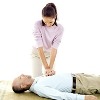
Brief Video Training Boosts Hands-Only CPR Attempts: AHA
Research has shown that bystander CPR can double — even triple — survival from out-of-hospital cardiac arrest.
Study participants who viewed a brief hands-only cardiopulmonary resuscitation (CPR) video were more likely to attempt CPR, and perform better quality CPR in an emergency than participants who did not view the short videos, according to research reported in Circulation: Cardiovascular Quality and Outcomes.
Each year, almost 300,000 people suffer out-of-hospital cardiac arrests in the United States. Survival rates from these events tend to be extremely low. However, research has shown that bystander CPR can double — even triple — survival from out-of-hospital cardiac arrest.
In the United States, bystanders attempt CPR only about 26 percent of the time, according to Bentley J. Bobrow, M.D., lead author of the study and clinical associate professor in the Department of Emergency Medicine in the Maricopa Medical Center in Phoenix and the University of Arizona Emergency Medicine Research Center.
“Chest compression-only CPR, also known as hands-only CPR, has been shown in studies to be at least as effective as standard CPR with mouth-to-mouth ventilation for adult primary cardiac arrest victims,” Bobrow said. “And because of its simplicity, hands-only CPR may be quicker and easier for lay rescuers to learn, remember and perform than conventional CPR.”
Bobrow and colleagues conducted a study of 336 adults without recent CPR training and randomized the participants into four groups:
- No training (control group of 51 participants)
- Ultra-brief video (UBV): watched a 60-second video (95 participants)
- Brief video (BV): watched a five-minute video (99 participants)
- Brief video with practice (BVP): watched an eight-minute video with a practice training session using a manikin (91 participants)
They then tested the participants’ ability to perform CPR during an adult out-of-hospital cardiac arrest simulation. About half of the trained participants underwent testing immediately and half after two months. They found that nearly a quarter (23.5 percent) of the untrained group did not attempt any CPR versus less than 1 percent (.7 percent) from all the training groups combined. Trained subjects in the immediate and delayed evaluation groups were significantly more likely to attempt CPR compared to untrained subjects.
All training groups had significantly higher median compression rates compared to the control group (62 compressions-per-minute). In the immediate testing group, the median rates of compressions-per-minute were: UBV (96), BV (95), and BVP (99.5). In the delayed testing group, the median compression rates were: UBV (94), BV (92.5) and BVP (90).
The ideal compression rate is 100 compressions per-minute, according to the American Heart Association’s 2010 Guidelines for CPR and Emergency Cardiovascular Care.
“This is the first controlled, randomized investigation evaluating the effectiveness of ultra-brief video training for teaching hands-only CPR to the lay public,” Bobrow said. “Given that the ultra-brief video training in our study is only 60 seconds, the CPR performance results are striking. This finding has enormous public health implications because of the documented hesitancy of untrained rescuers to even attempt CPR and because it is known that any bystander resuscitation attempt improves outcomes compared to no CPR.”
Additional resources: